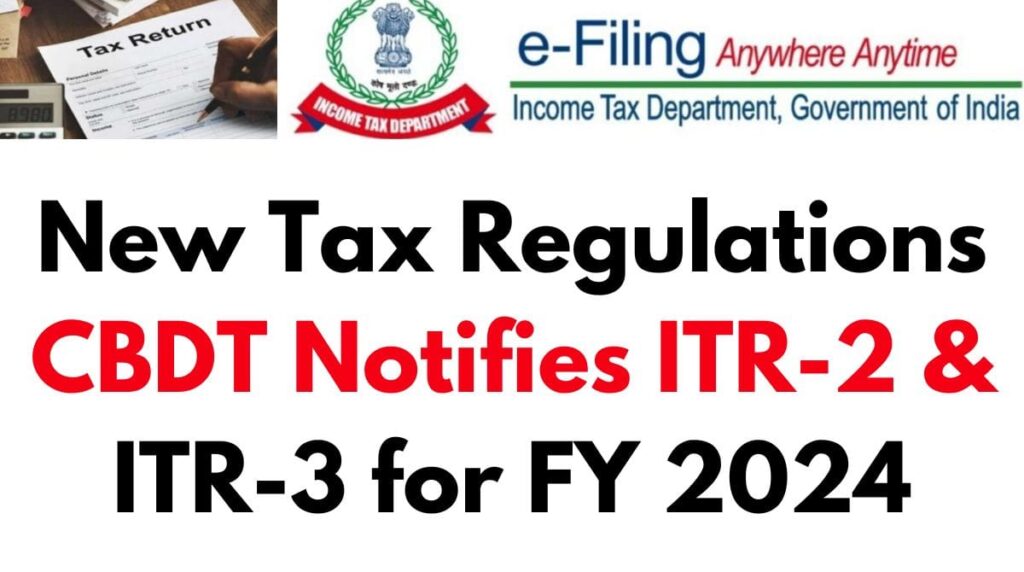New Tax Regulations (CBDT Notifies ITR-2 and ITR-3 for FY 2024): The Central Board of Direct Taxes (CBDT) has recently released the income tax return (ITR) forms, ITR-2 and ITR-3, which are to be used by taxpayers who earn more than Rs 50 lakh or own more than one house. These forms are applicable for the financial year 2024 (New Tax Regulations assessment year 2024-25). The deadline for filing ITR-2 and ITR-3 is July 31, 2024.
However, taxpayers who are required to undergo an income tax audit and have business income must file ITR-3 by October 31, 2024. To ensure compliance and gather necessary information, the tax department has introduced certain additional New Tax Regulations CBDT Notifies ITR-2 and ITR-3 for FY 2024 requirements.
Taxpayers are now required to provide details such as the Legal Entity Identifier (LEI), contributions made to political parties along with payment details, and information regarding deductions claimed for the care of a dependent with a disability, including medical expenses. The LEI is a unique code used to identify entities in the global financial system. It is particularly important for processing refunds that exceed ₹50 crore. These additional information requirements aim to enhance transparency and accountability in the income tax filing process. Taxpayers are advised to carefully review the new ITR forms and provide the requested information accurately and within the specified deadlines to avoid any penalties or complications in the future.
CBDT Notifies ITR-2 and ITR-3 for FY 2024
Eligible to file ITR-2:
Individuals or Hindu Undivided Families (HUFs) who meet the following criteria are eligible to file ITR-2 for AY 2021-22:
- They are not eligible to file ITR-1 (Sahaj).
- They do not have income from profit and gains of business or profession, and they also do not have income from profits and gains of business or profession in the form of interest, salary, bonus, commission, or remuneration received from a partnership firm.
- They have the income of another person, such as a spouse or minor child, to be clubbed with their income. This applies if the income to be clubbed falls into any of the above-mentioned categories.
10-Year Jail Term, Rs 1 Crore Fine: New Bill for Exam Paper Leak, Cheating
(ITR-U) Updated Income Tax Return Last date : 2 साल के अंदर भर सकते हैं Updated ITR, देखें डिटेल !!
2. Who is ineligible to file ITR-2?
ITR-2 cannot be filed by individuals or HUFs whose total income for the year includes income from profit and gains from business or profession, and who also receive income such as interest, salary, bonus, commission, or remuneration from a partnership firm.
3. What are the modifications in ITR-2 compared to previous years?
In the ITR-2 for AY 2021-22, individuals have the option to choose the new tax regime under section 115BAC. It is important to note that this option can only be selected until the due date of filing the return under section 139(1).
Structure of ITR-2:
ITR-2 is divided into two parts: Part A, which includes general information, and Part B-TI, which involves the computation of total income, and Part B-TTI, which calculates the tax liability on the total income.
ITR-3 Form:
The ITR-3 form is applicable for individuals and HUFs who have income from profits and gains from business or profession.
Individuals who have income from the following sources are eligible to file ITR-3:
- Engage in a business or profession (both tax audit and non-audit cases).
- The income tax return (ITR) for individuals may consist of various sources of income such as income from house property, salary/pension, capital gains, and income from other sources.
- However, if an individual does not meet the criteria to file Form ITR-1 (Sahaj), ITR-2, or ITR-4 (Sugam), they are required to file the ITR-3 form.
- In the fiscal year 2022-23, the ITR-3 form underwent certain revisions. These changes include the addition of a new schedule called VDA, which allows individuals to separately report their income from cryptocurrencies or other virtual digital assets (VDAs).
- If an individual treats their income from VDAs as capital gains, they will need to provide a quarterly breakup of these gains in the Capital Gains Schedule. Additionally, the new ITR-3 form requires individuals to report each VDA transaction along with the corresponding sale and purchase dates.
- Furthermore, the revised ITR-3 form includes additional questions to determine whether individuals had opted out of the New Tax Regime in previous years. Foreign institutional investors (FII/FPI) are also required to disclose their SEBI registration number as an additional measure.
- There has also been a minor change in the reporting of the balance sheet. As per the new ITR-3 form, advances received from individuals specified in Section 40A(2)(b) of the Income Tax Act, as well as others, must be reported under the ‘Advances’ category in the Source of Funds section.
- Lastly, individuals are now obligated to report their turnover and income from intraday trading under the newly introduced section called ‘Trading Account’ in the ITR-3 form.
New Rules for ITR File 2024-25: New Form 1 and ITR Form 4 | New tax Regime in ITR 2024
Did You Miss File Your ITR? Now Considering Penalties & Notices!
CBDT Notifies ITR-2 and ITR-3 for FY 2024
The CBDT releases updated ITR Forms annually, incorporating changes from the Finance Act of 2023. To enhance transparency and increase disclosure in claiming deductions, the department introduces new fields in the ITR Forms. The latest ITR Forms for the assessment year 2024-25 include additional fields such as the Legal Entity Identifier (LEI) number, acknowledgment number of the Audit Report and UDIN, and details of the Capital Gains Accounts Scheme.
Taxpayers are now required to provide more detailed information to claim deductions. Naveen Wadhwa, Vice President of Research and Advisory at Taxman stated that this initiative by the CBDT aims to promote greater accountability and transparency in tax compliance.

